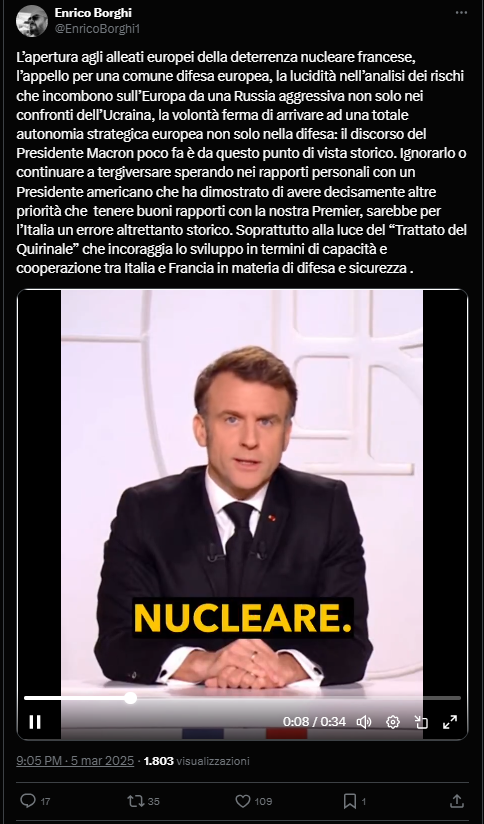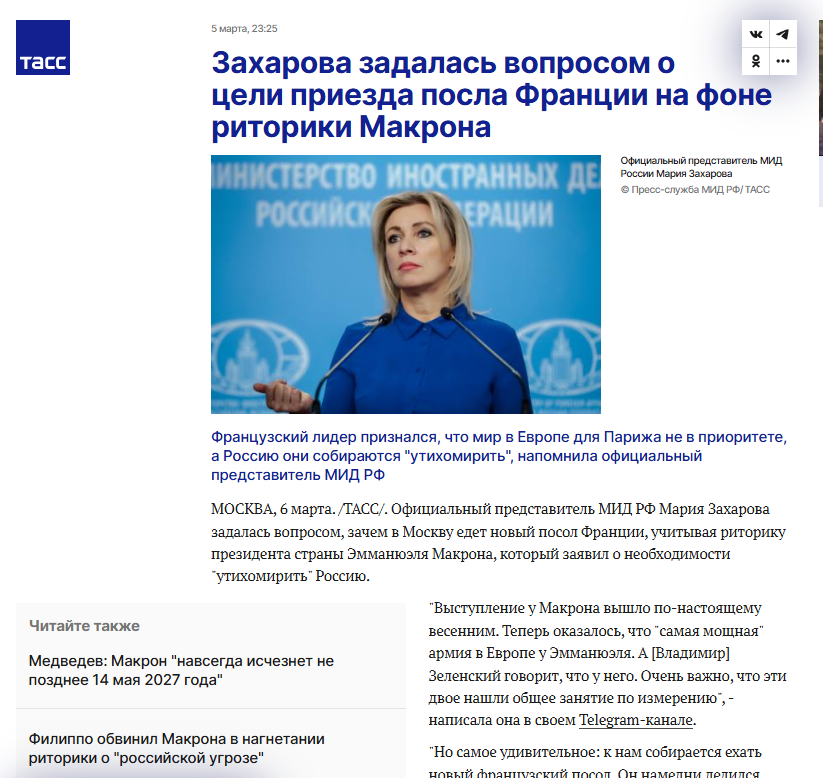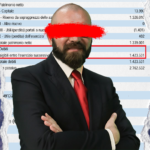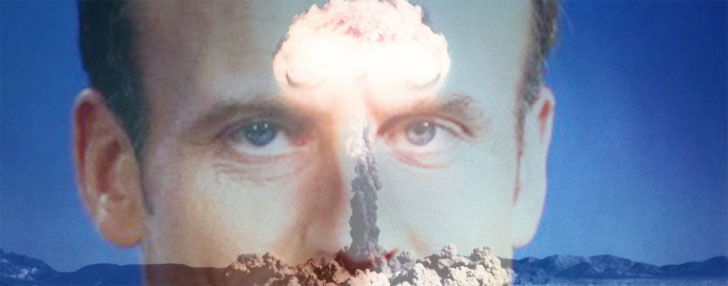Macron vs. Putin : A Nuclear Showdown Where France Risks Its Existence
Posted on March 6, 2025, by David Colantoni
Tweet On his X profile, Enrico Borghi—whose bio identifies him as a Senator of the Republic, Vice President of Italia Viva, and a member of the Foreign Affairs and Defense Commission and COPASIR—posted a subtitled video of Macron. Rather than seizing the opportunity presented by the United States for a negotiated solution and peace, Macron escalates the war with a speech as measured as it is unhinged, claiming he has opened a “strategic debate through French nuclear deterrence.” Borghi’s accompanying text, no less concerning, reads as follows:

“The opening of French nuclear deterrence to European allies, the call for a common European defense, the lucid analysis of the risks looming over Europe from an aggressive Russia—not only toward Ukraine—the firm resolve to achieve total European strategic autonomy in defense and beyond: President Macron’s speech earlier today is, from this perspective, historic. Ignoring it or continuing to dither in hopes of personal rapport with an American president who has clearly demonstrated other priorities than maintaining good relations with our Prime Minister would be a historic mistake for Italy. This is especially true in light of the ‘Quirinal Treaty,’ which encourages the development of capabilities and cooperation between Italy and France in matters of defense and security.”
These gravely alarming statements from a French president nearing the end of his tenure, yet clinging to power by grasping at anything—including wars—are as dangerous as they are absurd, given they could provoke a crisis they are utterly unprepared to face.
Without belaboring the point, a few concise observations will make it glaringly obvious that Macron’s move is nothing more than a self-serving publicity stunt. Let’s briefly analyze the nuclear weight of these potential adversaries in the context of a hypothetical nuclear confrontation.
It won’t take long to see exactly how things stand—and to reinforce our conviction that we’ve neglected the public sphere for too long, a grave fault of ours.
By failing to engage as we should have, we’ve allowed useless yet dangerous men to occupy its spaces, men whose incompetence now jeopardizes our very existence and has already shattered our well-being.
Let’s start with the numbers, the first indicator of the gaping disparity between these two powers.
Comparing the French and Russian Nuclear ArsenalsFrance:
France possesses approximately 290 operational nuclear warheads (per SIPRI 2023 data, likely stable through 2025 absent significant announced changes). Its nuclear force, known as the Force de Frappe, relies on two main components:
- Nuclear Missile Submarines (SNLE): Four Triomphant-class submarines, each carrying 16 M51 ballistic missiles, capable of delivering up to six warheads per missile (range: about 6,200 miles).
- Air Force: Rafale jets equipped with ASMP-A cruise missiles (range: 310 miles, 300-kiloton warhead). France’s doctrine is one of minimal deterrence (dissuasion), designed to inflict unacceptable damage on an aggressor but not to wage all-out nuclear war.
Russia: Russia boasts a far larger arsenal, estimated at around 5,977 total nuclear warheads (SIPRI 2023), with about 1,588 deployed operationally on intercontinental ballistic missiles (ICBMs), submarines, and strategic bombers, plus thousands in reserve or awaiting dismantlement. This includes:
- Land-based ICBMs: Systems like the RS-24 Yars and RS-28 Sarmat (“Satan-2”), with ranges of 6,800-11,200 miles and the ability to carry 10-15 MIRV (multiple independently targetable reentry vehicle) warheads.
- Submarines: A fleet of Borei-class submarines armed with Bulava missiles (6,200-mile range, 6-10 warheads).
- Tactical Weapons: Hundreds of short-range warheads (e.g., Iskander), usable in regional theaters. Russia’s doctrine encompasses both strategic deterrence and tactical use, offering greater flexibility than France’s.
Comparison:
The numerical gap is staggering—290 French warheads versus nearly 6,000 Russian ones, a ratio of roughly 1 to 20. Even counting only deployed warheads, Russia outnumbers France by more than five to one. In terms of destructive power, Russia can wreak havoc on a global scale, while France is limited to a regional or punitive strike. While France has four submarines with nuclear strike capabilities, let’s take a closer look at the estimated composition of Russia’s nuclear submarine fleet:
Russia’s Nuclear Ballistic Missile Submarines (SSBNs)
SSBNs are designed to carry intercontinental ballistic missiles with nuclear warheads, such as the Bulava. Russia’s fleet primarily consists of two active classes:
- Delta Class (Project 667BDRM and 667BDR): By 2025, an estimated 6-7 Delta submarines remain operational. The Delta IV (667BDRM) fleet numbers six, though some may be phasing out, while the Delta III (667BDR) is largely retired, with perhaps one still in limited service.
- Borei Class (Project 955/955A): The more modern class, with three Borei submarines commissioned between 2013 and 2014, and additional Borei-A units added since. By 2025, an estimated 7-8 Borei subs are operational, with a stated goal of reaching 10 by 2027-2030. In 2024, Russian Defense Minister Sergei Shoigu announced the addition of two new Borei-A SSBNs (e.g., the Kniaz Pozharskiy), bringing the total to about eight.
Total Estimated SSBNs: 11-13 (6-7 Delta + 7-8 Borei). Nuclear Attack Submarines (SSNs)
SSNs are nuclear-powered subs designed for attack missions, capable of carrying nuclear torpedoes or cruise missiles with nuclear warheads (e.g., nuclear-capable Kalibr variants). Key classes include:
- Yasen/Yasen-M Class (Project 885/885M): By 2025, about 5-6 Yasen subs are operational, with more under construction (targeting 9-10 by 2030). These can deploy Kalibr or Oniks missiles, some with nuclear warheads.
- Akula Class (Project 971): An estimated 6-8 Akula subs remain in service, though some are in maintenance or nearing retirement.
- Sierra Class (Project 945/945A): About 2-3 Sierra subs are operational, with nuclear torpedo capabilities.
- Others (e.g., Victor III, Project 671RTMK): Perhaps 1-2 aging units remain active.
Total Estimated SSNs: 14-19. Nuclear Cruise Missile Submarines (SSGNs)
SSGNs are nuclear-powered subs specialized in launching cruise missiles, some of which can carry nuclear warheads (e.g., Granit, Kalibr, or Zircon in nuclear variants). The main class is:
- Oscar II Class (Project 949A): About 6-8 Oscar II subs are in service, with two in the Northern Fleet and 4-5 in the Pacific Fleet. Some, like the K-132 Irkutsk, have been upgraded to the 949AM standard to carry Kalibr missiles.
- Belgorod Class (Project 09852): A unique vessel, operational since 2022, designed to carry the Poseidon nuclear-armed underwater drone (Status-6), with up to six nuclear warheads.
- Khabarovsk Class (Project 09851): Similar to the Belgorod, it may be operational by 2025, bringing the Poseidon-capable total to two.
Total Estimated SSGNs: 7-9. Overall Estimate
Adding up the categories:
- SSBNs: 11-13
- SSNs: 14-19
- SSGNs: 7-9
Total Estimated: 32-41 nuclear-capable submarines. This figure reflects the fleet’s status in 2025, factoring in retirements, maintenance, and new deliveries. Russia is heavily investing in modernizing its submarine fleet, particularly the Borei SSBNs and Poseidon SSGNs, potentially increasing numbers in the coming years.
Strategic Depth: Territory and Resilience
“Strategic depth” refers to a country’s ability to absorb a nuclear strike and keep its military and civilian structures operational. Here, the disparity is just as stark.
France: With a land area of about 248,000 square miles, France is relatively compact. Its major cities (Paris, Lyon, Marseille) and military bases are concentrated in a small area, making it vulnerable to a focused nuclear strike.
A Russian first strike with a few dozen high-yield warheads (e.g., 800 kilotons from the Sarmat) could obliterate France’s key nerve centers—government, economy, military command—in hours. With a population of 67 million, densely packed and urbanized, the potential losses would be catastrophic.
Russia: Spanning 6.6 million square miles, Russia is the world’s largest country, with immense strategic depth. Its key cities (Moscow, St. Petersburg) are prime targets, but military bases, nuclear stockpiles, and industries are scattered across vast regions, often in Siberia or the Urals, making simultaneous strikes difficult. Its 144 million people are more dispersed, and Russia has a long history of enduring devastating conflicts (e.g., World War II). Even a full French attack (say, all 290 warheads) could inflict massive damage—tens of millions dead, cities razed—but it wouldn’t eliminate Russia’s retaliatory capacity.
Comparison: France lacks the depth to survive a Russian first strike and respond effectively. Russia, by contrast, can absorb an attack and maintain a second-strike capability, thanks to its geographic sprawl and redundant systems.
Defense and Retaliation Capabilities
Another critical factor is the ability to intercept an attack and strike back. France: It lacks a strategic ballistic missile defense system comparable to the U.S. Aegis or Russia’s S-400/S-500. Its M51 and ASMP-A missiles are modern but limited in number and flexibility. Once launched, France would quickly exhaust its arsenal, with no capacity for a prolonged exchange.
Russia: It fields advanced systems like the S-400 and S-500, capable of intercepting ballistic and hypersonic missiles, though with limits against a massive attack. Russia’s nuclear triad (land, sea, air) ensures a guaranteed retaliation (mutual assured destruction, MAD), even after a first strike. Weapons like the hypersonic Avangard missile (currently uninterceptable) further bolster its edge.
Comparison:
France could hit Russia but couldn’t stop the counterstrike. Russia, with stronger defenses and a diversified arsenal, would dominate a nuclear exchange.
Nuclear Defense Infrastructure: A Decisive FactorRussia:
During the Cold War, the Soviet Union poured resources into nuclear protection infrastructure, a legacy Russia maintains. Notable examples include:
- Yamantau Bunker: A subterranean complex in the Urals, considered an alternate command center, capable of sheltering thousands.
- Metro-2: A secret tunnel network beneath Moscow for government and military use.
- Kosvinsky Kamen: Another underground site for operational continuity.
These facilities, built to withstand nuclear blasts and radiation, have been modernized and remain active, ensuring Russia can maintain command even after a devastating attack.
France: France has government bunkers (e.g., beneath the Élysée Palace) and shelters for state continuity, but nothing on the Soviet scale. Its strategy has focused on active deterrence (limited first strike), not surviving a prolonged nuclear conflict. There’s no evidence of an extensive underground network or resilient command centers like Russia’s.
Comparison:
Russia can shield its leadership and coordinate a counterstrike from advanced bunkers. France, with more limited infrastructure, would lose command capacity quickly in a nuclear exchange.
Doctrine and Political Will
Nuclear doctrine and willingness to use it differ between the two nations. France: Its policy is pure deterrence: nuclear weapons are a last resort if national survival is at stake. Macron might offer the Force de Frappe to the EU, but that would require political consensus among members (unlikely) and a willingness to escalate that Paris has historically avoided against a superpower like Russia.
Russia: Its doctrine allows nuclear use not just for defense but also to counter conventional existential threats or for “de-escalation” (paradoxically, a limited first strike to halt a conflict). Post-Ukraine, Russian rhetoric has shown a readiness to wield nuclear weapons as a political tool.
Comparison: France is more cautious, Russia more assertive. This makes it improbable that Paris would directly challenge Moscow, knowing the Kremlin might respond disproportionately.
Conclusion: Can France Challenge Russia Nuclearly?
No, not realistically. The gap is insurmountable, both in arsenal and strategic depth:
- Arsenal: 290 warheads versus nearly 6,000. France could inflict catastrophic damage (e.g., wiping out Moscow and other cities, killing millions), but Russia would respond with force sufficient to erase France as a functioning entity.
- Strategic Depth: France’s compactness makes it vulnerable to a decisive first strike, while Russia’s vastness allows it to absorb and retaliate.
- Retaliation: Russia has a guaranteed second-strike capability; France does not.
In a theoretical scenario:
- If France struck first, Russia would suffer immense losses but retain enough warheads to level France.
- If Russia struck first, France might not even have time to mount a full response, given the speed of Russian hypersonic missiles (e.g., 10-12 Mach).
Given this stark reality, it’s clear that France in a nuclear exchange with Russia would simply vanish from the geopolitical and geographic map as a historical entity and nation-state. This forces us to reflect: a head of state who escalates tensions with such delirious provocations in an already perilous scenario—fully aware of this unbridgeable gap in nuclear power and resilience—demonstrates a criminally deranged attitude toward his own people, whose existence he should safeguard but is instead gravely endangering.
We can only hope the peoples of Europe consign these unhinged figures to the finest suites in Europe’s top mental health facilities. Otherwise, if we don’t rid ourselves of these lunatics we’ve carelessly allowed into the halls of power, they’ll be the ones gifting us a long nuclear winter.
The Russian Reaction The Russian state news agency TASS has already published initial responses: “Macron’s speech was truly springlike. Now it turns out Emmanuel has Europe’s ‘most powerful’ army. And [Volodymyr] Zelensky agrees. It’s very important that these two have found a shared pastime in measuring,” wrote Foreign Ministry spokesperson Maria Zakharova on her Telegram channel, as reported by TASS. [https://tass.ru/politika/23319253]A screenshot of one of several TASS articles on Macron’s escalatory statements
“But the most surprising thing is that the new French ambassador will be visiting us. He recently shared his thoughts on wanting to develop relations with our country. Yet today, his president Macron admitted that peace in Europe isn’t a priority for France, that they’ll ‘pacify’ Russia and so on. So why is the French ambassador coming to us? I’d like that clarified again,” the diplomat noted.

Earlier, TASS reports, Macron addressed his citizens, claiming that threats to Europe and the republic—including alleged ones from Russia—were growing.
He justified the need to boost defense spending beyond previously approved plans. He also vowed to continue supporting Kyiv in its conflict with Russia and promised to launch a discussion on expanding France’s national nuclear deterrence to other European countries, following a call from German chancellor candidate Friedrich Merz.
END
The opinions expressed herein are strictly my own and do not necessarily align with those of the editorial board.
MY BOOKS
Ukraine 2022: The Perfect Strategic Threat
When Ukraine Invaded Iraq: The Pentagon’s Hands on History
General Outlines of the Treaty on the Armed Class
Contact Email: d.colantoni@young.it
Facebook
X












